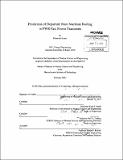Prediction of departure from nucleate boiling in PWR fast power transients
Author(s)
Lenci, Giancarlo
DownloadFull printable version (18.14Mb)
Alternative title
Prediction of departure from nucleate boiling in Pressurized Water Reactor fast power transients
Other Contributors
Massachusetts Institute of Technology. Department of Nuclear Science and Engineering.
Advisor
Kord S. Smith and Neil E. Todreas.
Terms of use
Metadata
Show full item recordAbstract
An assessment is conducted of the differences in predicted results between use of steady state versus transient Departure from Nucleate Boiling (DNB) models, for fast power transients under forced convective heat exchange conditions. Theoretical DNB models based on liquid film thickness variation are adapted and modified from existing studies into a generalized formulation to allow implementation into a reactor simulation code. The formulation is validated using experimental data available at low pressure. An application is performed at Pressurized Water Reactor (PWR) operating conditions, simulating rod ejection accidents. The transient DNB model is applied to PWR rod ejection accident cases computed by the reactor dynamics code SIMULATE-3K. Rod power profiles deriving from pin power reconstruction are used in a subchannel simulation done with VIPRE to obtain local pin parameters. Results show that a significant delay exists for the occurrence of transient DNB compared to quasi steady-state DNB and in some cases DNB does not occur, even if predicted by quasi steady-state methods. Most modem codes for PWR thermal hydraulic simulation use quasi steady-state approaches to predict DNB, thus applying a steady-state correlation to time-dependent cases. However, according to the transient DNB model used in this work, a time lag exists between DNB as predicted by steady-state correlations, and effective transient DNB. During that time lag, the liquid film between the wall and the bubbly layer thins until the heated surface is eventually dried out. Such DNB prediction by steady state models is a conservative estimate. This work assesses the consequences of the use of more accurate models for predicting transient DNB, which are desirable to get better knowledge of design margins, to allow optimization of plant safety and efficiency.
Description
Thesis (S.M.)--Massachusetts Institute of Technology, Dept. of Nuclear Science and Engineering, 2013. Cataloged from PDF version of thesis. Includes bibliographical references (p. 89-91).
Date issued
2013Department
Massachusetts Institute of Technology. Department of Nuclear Science and EngineeringPublisher
Massachusetts Institute of Technology
Keywords
Nuclear Science and Engineering.